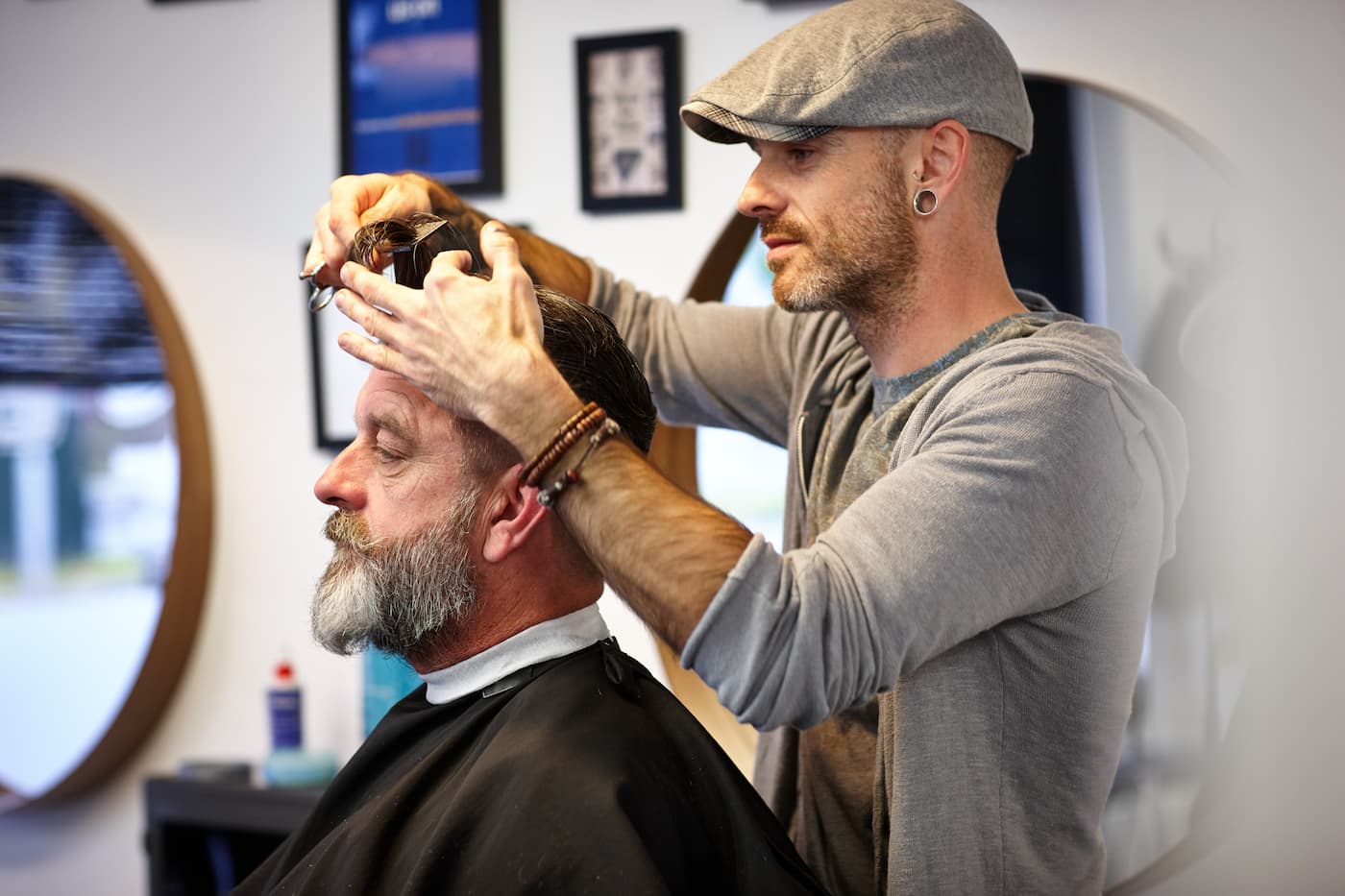How to open a barber shop
Editorial Team
9 min read
There is something classic about a neighborhood barber shop. The barber shop is a place where everyone comes together. It is as much about connecting with community as it is getting a fresh haircut or a shave.
While barber shops have been around for a long time, the barber industry has not been shy about integrating new technologies into their service model. If you are thinking of opening a barber shop, keep on reading to learn what you need to do to get started.
What are the steps involved in opening a barber shop?
Knowing the steps of opening a barber shop can help you stay on track and motivated throughout the process.
Perform market research
It can be tempting to skip this step, but that would be a mistake. Market research can help you figure out where to open your barber shop and the best audience to market to. It can help you avoid opening in a location that is oversaturated with barbers or other hair cutting businesses.
As a first step, determine your target audience. Is this a family barber shop where the kids will have their hair cut, too? Is this a barber shop where customers might want more than a typical haircut and shave, like eyebrow waxing or color services?
Once you have identified the audience and service offering, you can start to consider locations. A shopping plaza will have a different vibe from a small city storefront. Understanding your audience and your ideal location can help you stay patient through the real estate search.
As part of location, pay attention to the competition. Competition can be good for business in small doses. You never know when you will get a walk-in client because his go-to barber is too busy for a trim and your shop is right down the block — but if there are too many barbers in a small radius, it can be tough to stand out.
By the end of the market research phase, you should be able to articulate:
- Who your audience is
- Who your competitors are
- Location and branding of your competitors
- The services your competitors offer, including their prices
- Your sweet spot in the market — what is going to set you apart from the others?
Write a business plan
Write an official business plan. This is something that funders will want to see, but it is also an important document for internal use.
Incorporate the market research and analysis that you just completed, describe your barber shop business and its competitive advantages, talk about staffing and day-to-day operations, and, last but not least, include financials.
Choose a name/brand
Coming up with a name for your barber shop can be one of the most fun parts of starting a small business. This is where you can show that creative side and appeal to the audience you identified in step one.
Assuming you have picked something other than your name, you will need to register the business as a DBA, or “doing business as.” Having a DBA can help establish credibility with lenders and suppliers, keep your personal tax filings separate from the business, and make it easier to franchise in the future if you decide to go that route.
Make it legal
Before you register your small business, you’ll need to select your organization’s structure. A sole proprietorship can be the easiest one to set up if you are a business of one. If you’re going into the barber business with others, then you might want to consider a partnership a or a Limited Liability Company (LLC).
You will also want to obtain a business license. Requirements vary by state and local community, so make sure to check the current licensing requirements in your location. Some of these licenses may also require certain professional certifications.
Determine finances
You will need an initial capital investment to start a barber shop. While you may be planning to use some of your own money, chances are you may need to borrow from other sources in order to have enough.
Before you approach banks, online lenders, or even family and friends about financing, determine how much you’ll need.
Factor in variables such as:
- Real estate rental or purchase cost
- Licensing fees
- Insurance costs
- Startup equipment costs
- Marketing and advertising
- Labor costs (receptionist, other barbers, etc.)
How much does it cost to open a barber shop?
Most entrepreneurs spend anywhere from $50,000 to $150,000 to start a barber shop from scratch. While a range like this is useful to understand costs, how can you tell where your new business will fall? Two of the biggest factors are location and equipment.
If the rental space requires a remodel to fit your brand, you’ll need to create a budget for that depending on your vision. If the space is move-in ready, it’s to your financial benefit.
If you’re buying the building, then your costs are naturally going to be on the higher end, if not well above the range specified. The advantage to this is that you own the building, and if you decide to move or close your shop you can lease it out and make money as a proprietor.
Your startup costs are going to be more if you need supplies and equipment. If you’re leasing a space that used to be a hair salon and has all the right equipment, you may be able to save some money in the short-term.
Outside of real estate, operations are going to represent your largest upfront cost. Will you be hiring other barbers or a receptionist? The more people you need to hire, the more capital you will want to raise at the outset. You’ll also need to consider costs for business insurance, utilities, and taxes (sales and payroll).
Marketing is another expense to factor in. Your business is new. Without marketing no one will know that it exists. These days, you’ll want to plan on a website and social media presence. You may want to advertise on local media, throw an opening party, print up business cards, and take other steps to promote your new venture.
Marketing can pay for itself by bringing new customers to your business.
What do you need to start a barber shop?
At a minimum, you will need:
- Barber chairs
- While-you-wait seating
- Counter and mirrors
- Hair-washing sinks
- Barbering supplies (scissors, clippers, combs, styling products, etc.)
- Barber shop POS system
- Cleaning supplies
- Security system
- Telephone
Setting up operations
Operations refer to the day-to-day tasks involved with running the barbershop, which can include:
- Hiring and managing employees
- Training employees
- Scheduling appointments and taking payments
There are a few different ways to structure the employee relationship. You can rent or lease chairs to other barbers, who then pay you a flat rate or a percentage of every cut, or you can pay an hourly rate and hire barbers.
The choice is up to you and should reflect your location and customers’ needs.
If you have a great location, you can woo top-tier local barbers to come and work for you — or you can go the hourly rate approach and keep it simple.
Whatever route you take, plan on creating an employee manual or handbook. Outline any policies related to your business, such as attendance expectations, dress code, holidays, benefits, etc. You may also want to document opening and closing routines. Some of these tasks could include:
- Taking out the trash
- Securing the POS system
- Restocking supplies
- Cleaning public areas
- Depositing cash at the bank
Go into enough detail that an employee can follow your opening and closing routines exactly the same way you would.
These days, barber shop technology has evolved beyond the simple cash register. Many barbers double as style consultants, recommending their favorite products to customers. There is an opportunity here for additional commission income by selling products and services to clients.
Set yourself up for success by selecting a POS with advanced inventory management features.
Marketing/branding
Use your market research to help develop a marketing plan before you open. A marketing plan will cover both the marketing and branding of your business. Branding reflects your business logo, colors, tagline, and everything else that makes your business distinct from other barber shops.
In addition to online advertising and local media, include social media and a website in your marketing plan. Customers like to browse online when it comes to grooming. Having an active social media presence can help your barber shop stand out. Barbers can show off their latest styles and tag the salon, introducing customers to your shop.
To make it easier to put out social media content consistently, check out these small business social media tips.
Don’t overlook the importance of word-of-mouth marketing. In addition to killing it on social media with posts and reels, ask customers to recommend you to their friends.
Open your barber shop
This is the day you have dreamed about — the day you finally open your shop! Turn it into a celebration.
Invite friends and family, buy snacks, and have a local musician play a set. There are lots of little ways you can create a grand opening party that introduces your new shop to the local audience.
Set yourself up for a successful opening by planning ahead. Train employees. Make sure the shop is clean and all the little things, such as decoration, are taken care of.
Finally, don’t forget to test out your payment processing technology in advance. This way, you’ll know it all works when it comes to opening day.
Increase customer retention
Customer retention is what turns a walk-in haircut into a regular. Regulars are important because they represent recurring income for your barber shop business. You get to book a client every four weeks and the client gets the satisfaction of knowing the grooming is taken care of.
Dive into this blog post about customer retention to learn ways to turn a customer into a regular.
While there is a lot of work that goes into opening a barber shop from scratch, Clover can help you find the POS and business management solutions you need to help your business grow.
To learn more, talk to a Clover Business Consultant today.
CONTACT SALESThis information is provided for informational purposes only and should not be construed as legal, financial, or tax advice. Readers should contact their attorneys, financial advisors, or tax professionals to obtain advice with respect to any particular matter.
Related Posts
How to declutter your small business operations
How to start a retail pop-up shop–and why you need one
Popular Topics
Stay in touch
Sign up and learn more about Clover.
Thank you for your subscription!
More posts about starting a small business
eBook





